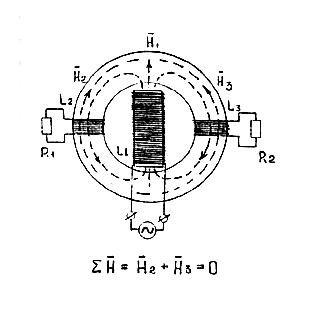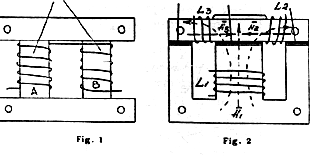
The terms "F-machine" and "F-transformer" are connected with a form of magnetic flux force lines for this type of system.

Fig.1 shows a device that uses permanent magnets as the rotor. The magnetic
flux is concentrated in
ferromagnetic ring. The structure of this field consists of two parts.
The direction of flux in one part is opposite to the direction of flux
in the other part.
The coil L is an ordinary coil of wire. In strength of electromagnetic induction principle the electro-motive force EMF is generated in coil L when rotor is revolving and flux H is changing. If the load is connected to coil L the secondary flux H is created.
The secondary flux tries to compensate any changes of the primary flux. Since in F-machine the secondary flux a created inside the ring it works against the primary flux only on half-period ot the ring, and it is co-directional to the primary flux in the other half-period of the ring.
The total effect of secondary flux is equal to zero.

Fig. 2 shows a similar version of bidirectional operation mode. The coil L1 is loaded with the AC generator. The coils L2 and L3 create two opposite magnetic fluxes H2 and H3 Total effect of creation of power in loads is equal to zero.
The number of secondary coils is not limited. The value of power in one coil is a function of velocity of the primary flux changes similar to conventional calculations. The consolidation of secondary coils to increase total output power is possible after rectification of every current since currents in different coils are not coherent.
The general principle is the creation of a bidirectional power process. It is not possible to get power in load without connection between cause and effect but it is possible to create two opposite effects for one cause.
The total effect is equal to zero in this case.
According to Dr. Aspden this "experiment (his Fig.1) gives the "free energy" answer, but he wrote: "to my surprise, with the coil arrangement shown in (Aspden's) Fig. 2. I found that the free energy becomes available well below the knee of the B-H curve at quite normal flux densities! Even at one-fifth of magnetic saturation levels, the excess free energy potential can exceed the input power and give a twice-unity factor of performance".

Hi All,
a toroidal overunity generator has been build
according similar to figure 1 at:
http://www.time-machine.spb.ru/ph-machine.htm
(Not by Mr. Frolov in this case , I just use
this picture for reference, the source wants to stay anonymous, until his
patent application is done and university verification tests will be done)
The claims are: 1200 Watts coil out with about
1076.4 Watts in into the driving motor at 3450 RPM.
8 amps @117volts at noload
9.2 amps @117 volts at full load
The output of about 1200 Watts is already a total overunity operation !
As they just increase the input power by about
140 Watts only between idle and load state and they get 1200 Watts output
it seems indeed a case, where Lenz law is violated ! (the driving motor
is inefficient in this case)
This generator also has NO motor effect ! If you
supply current to the coil, the permanent magnet
in the center will not rotate, cause the flux
just stays inside the toroid core !
There you can see, that the back drag does not influence the mechanical rotation of the magnet !
Regards, Stefan.
--
Hartmann Multimedia Service,
Dipl. In. Stefan Hartmann, Keplerstr. 11 B, 10589
Berlin, Germany
Tel: +49 30 345 00 497, FAX: +49 30 345 00 498
email: harti@harti.com info@ccard.net
http://ccard.net fuer Ihren Verkauf im WEB !